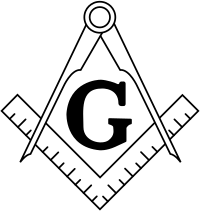
Freemasonry or Masonry refers to fraternal organisations that trace their origins to the local guilds of stonemasons that, from the end of the 14th century, regulated the qualifications of stonemasons and their interaction with authorities and clients. Modern Freemasonry broadly consists of two main recognition groups: Regular Freemasonry, which insists that a volume of scripture be open in a working lodge, that every member professes belief in a Supreme Being, that no women be admitted, and that the discussion of religion and politics do not take place within the lodge; and Continental Freemasonry, which consists of the jurisdictions that have removed some, or all, of these restrictions.

A Masonic lodge, often termed a private lodge or constituent lodge, is the basic organisational unit of Freemasonry. It is also commonly used as a term for a building in which such a unit meets. Every new lodge must be warranted or chartered by a Grand Lodge, but is subject to its direction only in enforcing the published constitution of the jurisdiction. By exception the three surviving lodges that formed the world's first known grand lodge in London have the unique privilege to operate as time immemorial, i.e., without such warrant; only one other lodge operates without a warrant – the Grand Stewards' Lodge in London, although it is not also entitled to the "time immemorial" title. A Freemason is generally entitled to visit any lodge in any jurisdiction in amity with his own. In some jurisdictions this privilege is restricted to Master Masons. He is first usually required to check, and certify, the regularity of the relationship of the Lodge – and be able to satisfy that Lodge of his regularity of membership. Freemasons gather together as a Lodge to work the three basic Degrees of Entered Apprentice, Fellowcraft, and Master Mason.
The history of Freemasonry encompasses the origins, evolution and defining events of the fraternal organisation known as Freemasonry. It covers three phases. Firstly, the emergence of organised lodges of operative masons during the Middle Ages, then the admission of lay members as "accepted" or "speculative" masons, and finally the evolution of purely speculative lodges, and the emergence of Grand Lodges to govern them. The watershed in this process is generally taken to be the formation of the first Grand Lodge in London in 1717. The two difficulties facing historians are the paucity of written material, even down to the 19th century, and the misinformation generated by masons and non-masons alike from the earliest years.
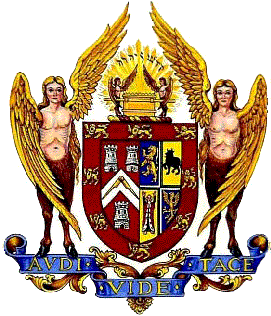
The United Grand Lodge of England (UGLE) is the governing Masonic lodge for the majority of freemasons in England, Wales, and the Commonwealth of Nations. Claiming descent from the Masonic Grand Lodge formed 24 June 1717 at the Goose & Gridiron Tavern in London, it is considered to be the oldest Masonic Grand Lodge in the world, together with the Grand Lodge of Scotland, and the Grand Lodge of Ireland.

Freemasonry in Malta has a lengthy history dating from the eighteenth century. The main masonic influences have been from the United Grand Lodge of England, the Grand Lodge of Scotland, and the Grand Lodge of Ireland. Today Regular Freemasonry is under the jurisdiction of the Sovereign Grand Lodge of Malta, formed in 2004.
A Grand Lodge, also called Grand Orient or by another similar title, is the overarching governing body of a fraternal or other similarly organized group in a given area, usually a city, state, or country.
The Grande Loge Nationale Française (GLNF) is a French Masonic Grand Lodge. It was founded in 1913, by two lodges, "Le Centre des Amis" Lodge splitting from Grand Orient de France and "L'Anglaise" lodge, an independent lodge based in Bordeaux. GLNF is based on monotheism and the 1929 precepts of regularity issued by the United Grand Lodge of England.
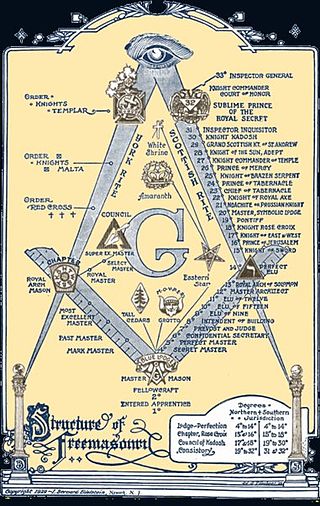
There are many organisations and orders which form part of the widespread fraternity of Freemasonry, each having its own structure and terminology. Collectively these may be referred to as Masonic bodies, Masonic orders, Concordant bodies or appendant bodies of Freemasonry.
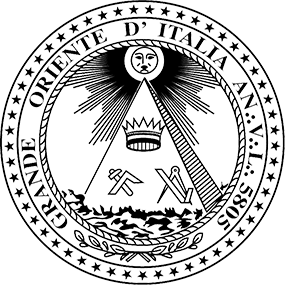
The Grand Orient of Italy (GOI) is an Italian masonic grand lodge founded in 1805; the viceroy Eugene of Beauharnais was instrumental in its establishment. It was based at the Palazzo Giustiniani, Rome, Italy from 1901 until 1985 and is now located at the Villa del Vascello. Its current Grand Master is Italian journalist Stefano Bisi.
This is a general survey on the historical and modern presence of Freemasonry in countries located in Asia.
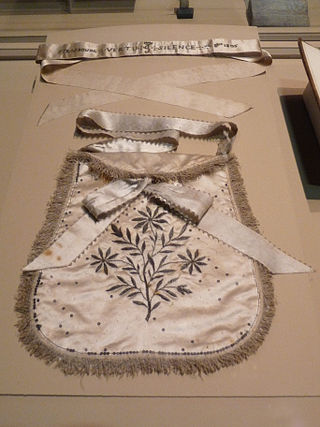
Freemasonry has had a complex relationship with women for centuries. A few women were involved in Freemasonry before the 18th century, despite de jure prohibitions in the Premier Grand Lodge of England.

The Ancient Grand Lodge of England, as it is known today, or The Grand Lodge of the Most Ancient and Honourable Fraternity of Free and Accepted Masons as they described themselves on their warrants, was a rival Grand Lodge to the Premier Grand Lodge of England. It existed from 1751 until 1813 when the United Grand Lodge of England was created from the two Grand Lodges. They are now called the Antients, in contrast to the Moderns, the original Grand Lodge which its critics, notably Laurence Dermott, said had moved away from the ritual of Scotland, Ireland, and now the Antient Grand Lodge. This Grand Lodge was also informally called the Atholl Grand Lodge because the Third and Fourth Dukes of Atholl presided over it as Grand Masters for half of its 62-year existence.
Continental Freemasonry, otherwise known as Liberal Freemasonry, Latin Freemasonry, and Adogmatic Freemasonry, includes the Masonic lodges, primarily on the European continent, that recognize the Grand Orient de France (GOdF) or belong to CLIPSAS, SIMPA, TRACIA **, CIMAS, COMAM, CATENA, GLUA, or any of various other international organizations of Liberal, i.e., Continental Freemasonry. The larger number of Freemasons, most of whom live in the United States–where Regular Freemasonry holds a virtual monopoly–belong to Masonic lodges that recognize the United Grand Lodge of England and do not recognize Continental Freemasons, regarding them as "irregular".

Masonic ritual is the scripted words and actions that are spoken or performed during the degree work in a Masonic lodge. Masonic symbolism is that which is used to illustrate the principles which Freemasonry espouses. Masonic ritual has appeared in a number of contexts within literature including in "The Man Who Would Be King", by Rudyard Kipling, and War and Peace, by Leo Tolstoy.
Freemasonry in Belgium comprises several Masonic obediences, a federation and a confederation. These include Grand Orient of Belgium, the Grand Lodge of Belgium, the Regular Grand Lodge of Belgium, the Women's Grand Lodge of Belgium, the Belgian Federation of Le Droit Humain and Lithos Confederation of Lodges.
Continental Freemasonry in North America is relatively rare, but there are a few continental-style organizations active.
The first known Freemasons in Portugal were the Swiss John Coustos and two other Portuguese members of his lodge, who were arrested by the Portuguese Inquisition and questioned under torture in the 1740s. Coustos wrote a book detailing his sufferings under the Inquisition and pointed to 1728 as being the year of the first Lodge, although nothing is known of the first years of this Lodge and it was not then recognised by the Grand Lodge of England. Today there are several Masonic Obediences in Portugal.

Anglo-American Freemasonry is a loose network of overlapping chains of mutually recognized Grand Lodges, forming a Regular Masonic jurisdiction. For the most part these trace their descent from one of "original" British Grand Lodges, with mutual recognition based on adherence to certain core values, rules and membership requirements.

The Grand Lodge of Cyprus, or in the Greek language, Μεγάλη Στοά της Κύπρου, is the sovereign governing body of freemasonry within the Republic of Cyprus. Its formal English name is "The Most Worshipful Grand Lodge of Cyprus, Ancient Free and Accepted Masons." While four of its constituent lodges are approaching 100 years of age, the Grand Lodge of Cyprus itself came into being on February 15, 2006. Thus it is one of the youngest grand lodges in the world.
Freemasonry in Scotland in lodges chartered by the Grand Lodge of Scotland comprises the Scottish Masonic Constitution as regular Masonic jurisdiction for the majority of freemasons in Scotland. There are also lodges operating under the Scottish Masonic Constitution in countries outside of Scotland. Many of these are countries linked to Scotland and the United Kingdom through the Commonwealth of Nations and prior colonies and other settlements of the British Empire although there are several lodges in countries such as Lebanon, Belgium, Chile and Peru, which do not have such connections.

